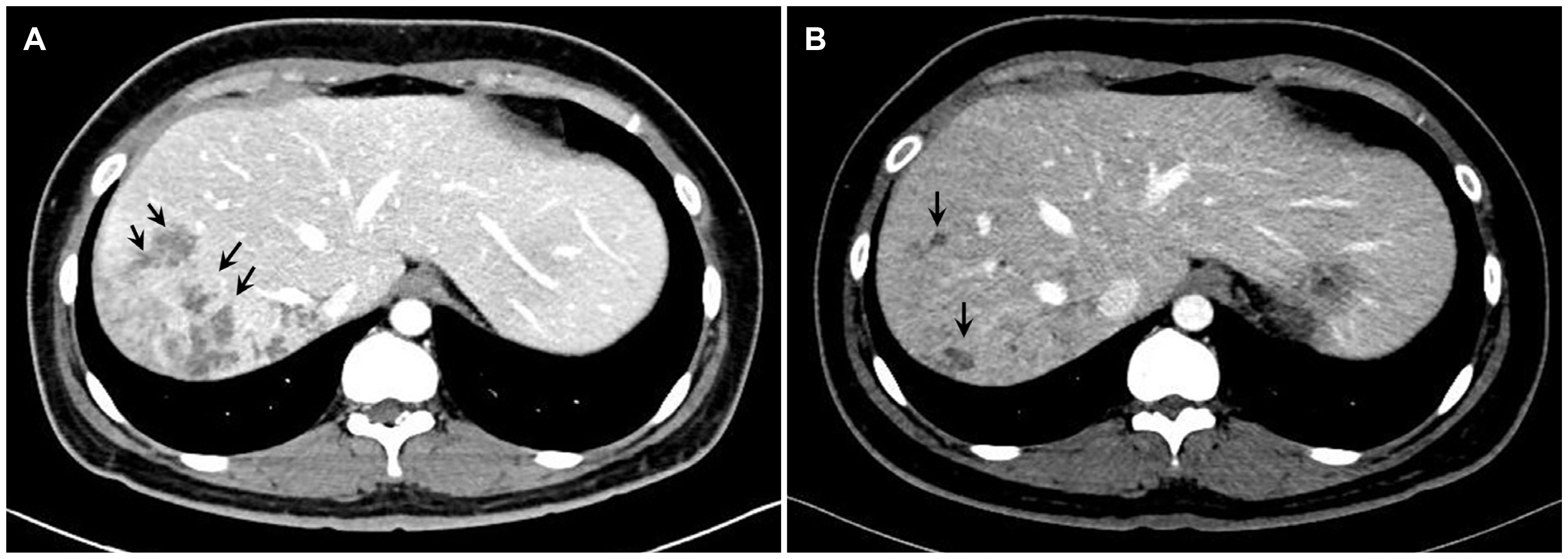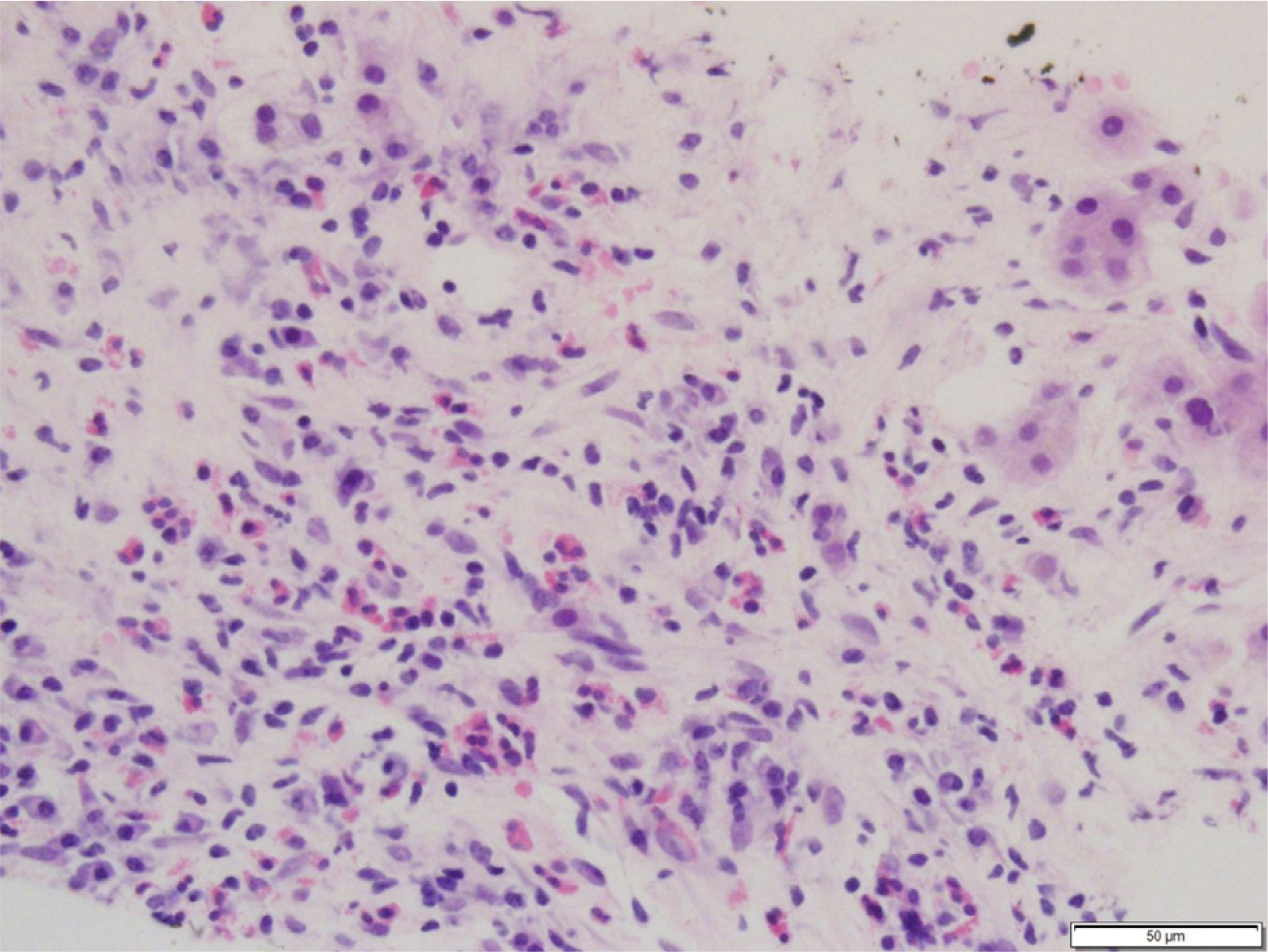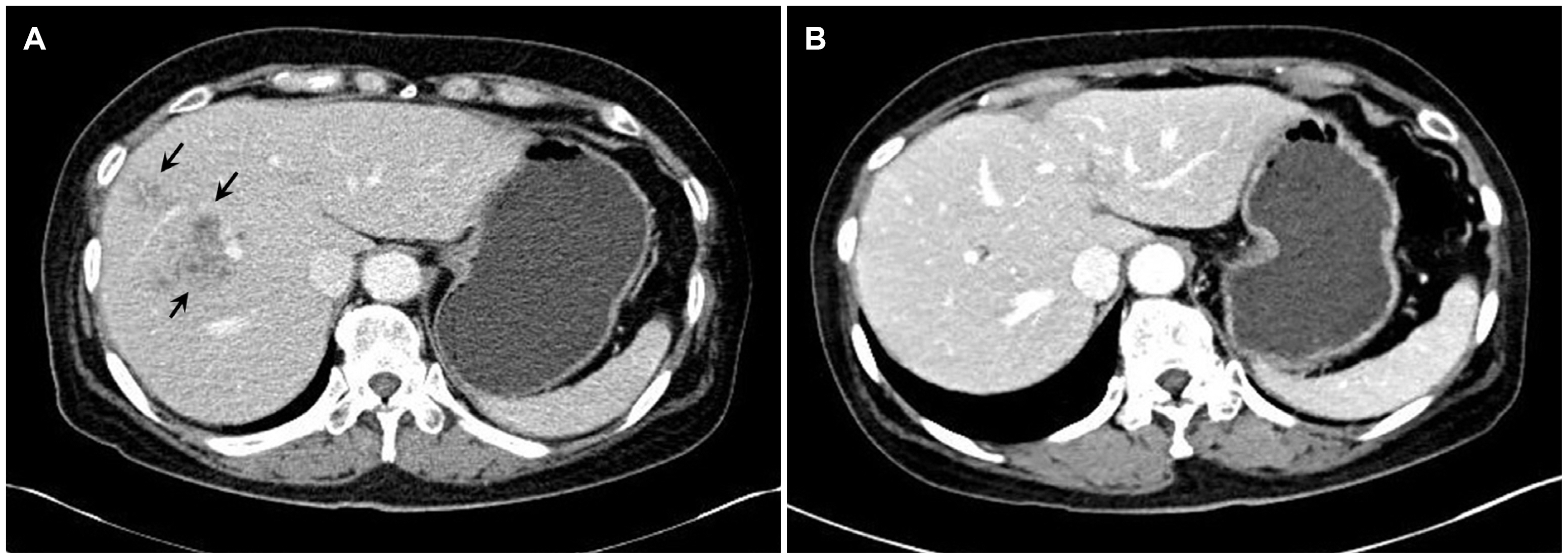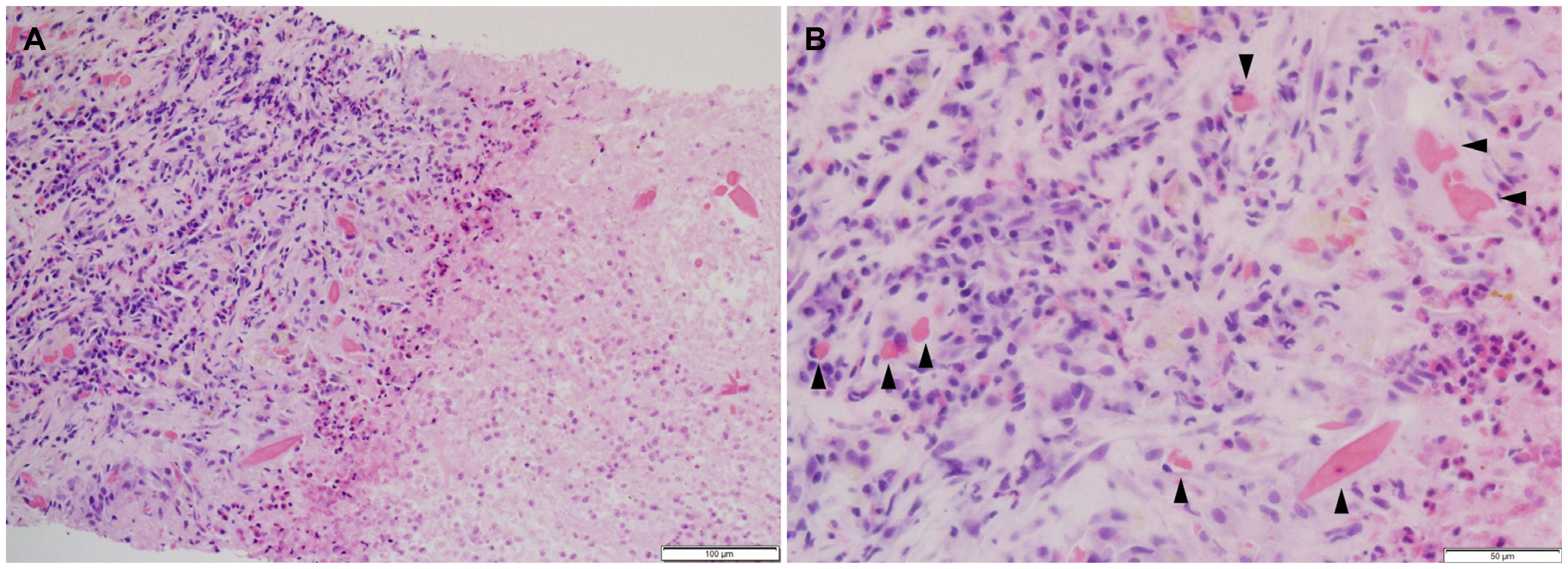Korean J Gastroenterol.
2021 Jan;77(1):39-44. 10.4166/kjg.2020.152.
Fasciola Hepatica Induced Hepatic Abscess Treated with Triclabendazole
- Affiliations
-
- 1Department of Internal Medicine, Kosin University College of Medicine, Busan, Korea
- 2Chang Kee-Ryo Memorial Liver Institute, Busan, Korea
- 3Department of Pathology, Kosin University College of Medicine, Busan, Korea
- KMID: 2510775
- DOI: http://doi.org/10.4166/kjg.2020.152
Abstract
- Fascioliasis is a zoonotic disease caused by Fasciola Hepatica that infects mainly cattle, sheep, and goats. Humans can be infected by water or aquatic plants contaminated with metacercariae. The authors encountered two cases of F. hepatica infection. One patient reported abdominal discomfort with marked eosinophilia. The other patient had chest discomfort with marked eosinophilia. The abdominal CT images revealed hypodense lesions in the liver. The ultrasonography-guided liver biopsy findings in both patients were indicative of parasitic infections. Serological tests confirmed the definite diagnoses. Both patients were treated with a single dose of triclabendazole, which is the treatment of choice for fascioliasis. These findings suggest that a diagnosis of fascioliasis, particularly in the acute phase, should be considered in patients with abdominal pain, marked eosinophilia, and hypodense hepatic lesions on CT.
Figure
Reference
-
1. Keiser J, Utzinger J. 2009; Food-borne trematodiases. Clin Microbiol Rev. 22:466–483. DOI: 10.1128/CMR.00012-09. PMID: 19597009. PMCID: PMC2708390.
Article2. Mas-Coma S, Bargues MD, Valero MA. 2005; Fascioliasis and other plant-borne trematode zoonoses. Int J Parasitol. 35:1255–1278. DOI: 10.1016/j.ijpara.2005.07.010. PMID: 16150452.
Article3. Kim YH, Kang KJ, Kwon JH. 2005; Four cases of hepatic fascioliasis mimicking cholangiocarcinoma. Korean J Hepatol. 11:169–175. DOI: 10.1016/0168-8278(90)90199-2. PMID: 15980676.4. Kang BK, Jung BK, Lee YS, et al. 2014; A case of Fasciola hepatica infection mimicking cholangiocarcinoma and ITS-1 sequencing of the worm. Korean J Parasitol. 52:193–196. DOI: 10.3347/kjp.2014.52.2.193. PMID: 24850964. PMCID: PMC4028458.5. Ha JS, Choi HJ, Moon JH, et al. 2015; Endoscopic extraction of biliary fascioliasis diagnosed using intraductal ultrasonography in a patient with acute cholangitis. Clin Endosc. 48:579–582. DOI: 10.5946/ce.2015.48.6.579. PMID: 26668810. PMCID: PMC4676668.
Article6. Marcos LA, Terashima A, Gotuzzo E. 2008; Update on hepatobiliary flukes: fascioliasis, opisthorchiasis and clonorchiasis. Curr Opin Infect Dis. 21:523–530. DOI: 10.1097/QCO.0b013e32830f9818. PMID: 18725803.
Article7. Aksoy DY, Kerimoğlu U, Oto A, et al. 2006; Fasciola hepatica infection: clinical and computerized tomographic findings of ten patients. Turk J Gastroenterol. 17:40–45. PMID: 16830276.8. Fica A, Dabanch J, Farias C, Castro M, Jercic MI, Weitzel T. 2012; Acute fascioliasis--clinical and epidemiological features of four patients in Chile. Clin Microbiol Infect. 18:91–96. DOI: 10.1111/j.1469-0691.2011.03575.x. PMID: 21668579.
Article9. Dusak A, Onur MR, Cicek M, Firat U, Ren T, Dogra VS. 2012; Radiological imaging features of fasciola hepatica infection - a pictorial review. J Clin Imaging Sci. 2:2. DOI: 10.4103/2156-7514.92372. PMID: 22347685. PMCID: PMC3279695.
Article10. Kaya M, Beştaş R, Cetin S. 2011; Clinical presentation and management of Fasciola hepatica infection: single-center experience. World J Gastroenterol. 17:4899–4904. DOI: 10.3748/wjg.v17.i44.4899. PMID: 22171131. PMCID: PMC3235633.11. Acosta-Ferreira W, Vercelli-Retta J, Falconi LM. 1979; Fasciola hepatica human infection. Histopathological study of sixteen cases. Virchows Arch A Pathol Anat Histol. 383:319–327. DOI: 10.1007/BF00430249. PMID: 158874.12. Espinoza JR, Maco V, Marcos L, et al. 2007; Evaluation of Fas2-ELISA for the serological detection of Fasciola hepatica infection in humans. Am J Trop Med Hyg. 76:977–982. DOI: 10.4269/ajtmh.2007.76.977. PMID: 17488926.13. Bektaş M, Dökmeci A, Cinar K, et al. 2010; Endoscopic management of biliary parasitic diseases. Dig Dis Sci. 55:1472–1478. DOI: 10.1007/s10620-009-0850-0. PMID: 19513838.
Article14. Gulsen MT, Savas MC, Koruk M, Kadayifci A, Demirci F. 2006; Fascioliasis: a report of five cases presenting with common bile duct obstruction. Neth J Med. 64:17–19. PMID: 16421437.15. Patrick DM, Isaac-Renton J. 1992; Praziquantel failure in the treatment of Fasciola hepatica. Can J Infect Dis. 3:33–36. DOI: 10.1155/1992/864093. PMID: 22451761. PMCID: PMC3307422.16. Keiser J, Engels D, Büscher G, Utzinger J. 2005; Triclabendazole for the treatment of fascioliasis and paragonimiasis. Expert Opin Investig Drugs. 14:1513–1526. DOI: 10.1517/13543784.14.12.1513. PMID: 16307491.
Article17. Krsak M, Patel NU, Poeschla EM. 2019; Case report: hepatic fascioliasis in a young afghani woman with severe wheezing, high-grade peripheral eosinophilia, and liver lesions: a brief literature review. Am J Trop Med Hyg. 100:588–590. DOI: 10.4269/ajtmh.18-0625. PMID: 30628571. PMCID: PMC6402889.
Article18. Sapmaz F, Kalkan IH, Guliter S, Nazlıoğlu A. 2013; A clinical presentation of a very rare infection: parenchymal Fasciola hepatica. Turkiye Parazitol Derg. 37:305–306. DOI: 10.5152/tpd.2013.2998. PMID: 24412878.19. Sah R, Khadka S, Khadka M, et al. 2017; Human fascioliasis by Fasciola hepatica: the first case report in Nepal. BMC Res Notes. 10:439. DOI: 10.1186/s13104-017-2761-z. PMID: 28870243. PMCID: PMC5583974.
Article20. Wang JK, Ma WJ, Lu Q, et al. 2017; First case report of retroperitoneal metastasis of fascioliasis after surgery. Medicine (Baltimore). 96:e9258. DOI: 10.1097/MD.0000000000009258. PMID: 29390366. PMCID: PMC5815778.
Article
- Full Text Links
- Actions
-
Cited
- CITED
-
- Close
- Share
- Similar articles
-
- Toxocara canis and Fasciola hepatica Co-Infection Leading to Hepatic Abscess: A Case Report
- Fascioliasis: Image Findings, Diagnosis, and Treatment
- A Case of Fasciolia Liver Abscess with Severe Eosinophilia in a Child
- Human Cases of Fascioliasis in Fujian Province, China
- Clinical Response to 7-Day Praziquantel Therapy in Fasciola Liver Abscess





